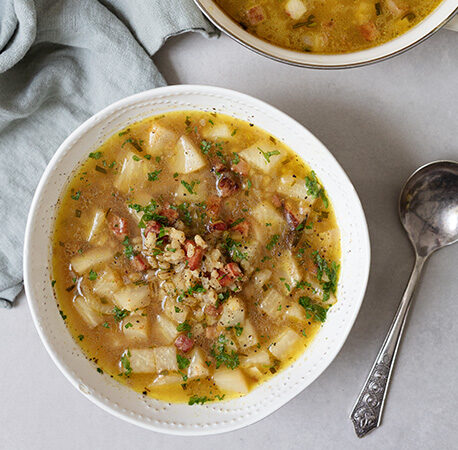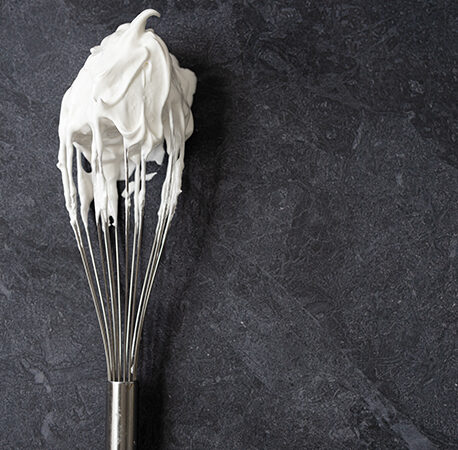Macarons are often made in beautiful pastel colours and are such an elegant bake. They have a crunchy exterior with a chewy texture. Filled with delicious curd, coulis, jam or buttercream, you really don’t know what surprise may be waiting inside. I am going to guide you through the ways of the macaron.
What is a macaron?
The French macaron is a small sandwich cookie traditionally made with ground almonds and French meringue. It can be sandwiched with a variety of fillings such as jam, curd or buttercream. The shell is quite subtle in flavour, so the fillings are typically where most of the taste comes from. The shells have smooth tops and ruffled bottoms referred to as “feet.” Both the shells and fillings come in a variety of colors.
Find our basic vanilla macaron recipe here.
The dry ingredients

One of the main ingredients in macarons is ground almonds. They do come ready ground, but it is a good rule of thumb to still give them a blitz in the food processor. You should always blend your ground almonds with the icing sugar, otherwise you may end up with almond butter. After you have given the icing sugar and the ground almonds a blitz, pass them through a sieve to remove any lumps or large pieces of almond.
Click here for our raspberry macaron recipe
The meringue

Before attempting to make meringue, your bowl and utensils need to be spotlessly clean and dry – meringues are very sensitive and do not like grease or moisture! Give your mixing bowl, whisk and any other utensils a good clean with soap and boiling water and make sure to dry them thoroughly. Kitchen paper is the best option for this.
Your eggs should be at room temperature as they will whip up much faster than colder eggs and will get better volume. If you do store your eggs in the fridge, allow them to sit at room temperature for 30 minutes before whipping.
Click here for our coconut and passion fruit macaron recipe
Keep on foldin’

After the meringue is whipped, it is time to start the folding process. This step is referred to as the “macaronage,” and it’s often the step people worry about the most. Just take your time folding; you don’t have to be super gentle, but be sure not to completely deflate the batter before it is fully mixed. Once the mixture starts to come together, you can continue to cut and fold, as at this stage you can start to knock out some of the air. The goal here is to evenly incorporate the dry ingredients into the meringue while deflating the batter just a bit. The finished batter should stream off the spatula in ribbons and slowly sink back into itself. You want the mixture to be loose enough that the shells smooth out as you pipe them, but not so loose the batter runs all over the place and loses shape.
Click here for our pistachio macaron recipe
Piping

You can buy silicone mats that have a macaron template already on them. To ensure an even batch, a good tip is to trace circles onto a piece of paper and slide it under your parchment paper. (If you trace them directly onto the parchment they will leave a mark on the macaroons.) If you are feeling adventurous, go wild and pipe them freehand. You can use a tiny dot of batter on the tray to stick down the parchment, to avoid it sliding around. Pipe at a 90˚ angle and squeeze the back of the bag with your good hand, using your other hand as a guide. To get the smoothest top, you’ll want to flick the piping tip away as you stop squeezing.
Click here for our hazelnut chocolate macaron recipe
Take a rest

Once they are piped, the next step is to bang the tray on the counter. This will remove any large air bubbles; without this step, the macarons will crack in the oven. Don’t worry about banging the tray too hard, as they should still hold shape.
The macarons now sit at room temperature to let the surface of the shells dry out and form a crust. This method will trap steam and force it out the bottom of the shell to form ‘feet’. The macarons are ready when they feel dry to the touch and their tops don’t stick to your finger.
Click here for our lemon macaron recipe
All about that bake

The baking time and temperature is an important part when it comes to macarons. Everyone’s oven is different and we all eventually get to our own like the back of our hand. Oven temperatures and times are always going to be a general guide when it comes to macarons. The macarons are done when you can gently nudge a shell with your finger and it doesn’t move. This indicates that the centre has fully set.
Fun with fillings

When you are planning what flavour of macaroon you want to make, remember you eat with your eyes first. Don’t be afraid to add a little food colouring to mirror what flavour is inside, for example adding a little yellow for lemon. You can have a lot of fun with different fillings. Whether you make zesty curds, rich ganache or adding different fruit and chopped nuts to buttercream, feel free to experiment.
Click here for our basic vanilla macaron recipe
Click here for our lemon macaron recipe
Click here for our hazelnut chocolate macaron recipe
Click here for our coconut and passion fruit macaron recipe
Click here for our pistachio macaron recipe
Click here for our raspberry macaron recipe
- summer events
- small business
- gut health
- OATLY
- healthy
- Crudo
- top tips
- All Together Now
- fridge cake
- Events Waterford
- me auld flower
- Events Ireland
- food festival
- news
- dublin
- events Dublin
- dublin festival
- Home-Cooking
- food and drink festival
- online cooking course
- festival line-up
- cooking
- Summer festival
- eco-friendly
- Events
- cosy
- Festivals Ireland
- wine
- Body & Soul
- grapes
- music festival
- south africa






You have to be signed in to comment this post.